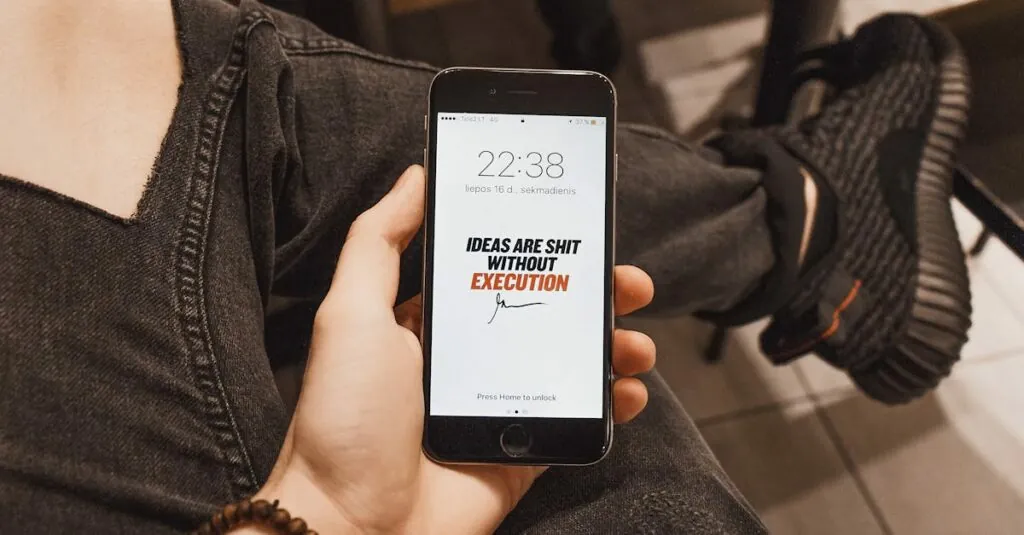Table of Contents
ToggleLocking the screen on an iPhone 13 might seem as simple as pressing a button, but it’s more than just a safety feature—it’s your personal fortress against accidental selfies and unintentional app launches. Imagine your phone suddenly deciding to call Aunt Edna while you’re in the middle of a meeting. Yikes!
Understanding The Importance Of Locking Your iPhone 13 Screen
Locking the screen on an iPhone 13 serves as a vital security measure. It prevents unauthorized access and protects sensitive information housed within the device. Users can safeguard personal data, such as photos, messages, and banking apps by engaging the lock feature.
Locking the screen stops accidental actions. Users may unintentionally launch apps or take photos by simply brushing against the screen. While these might seem minor, such blunders can lead to unintended outcomes, including embarrassing moments during crucial times.
Redundant notifications occur without a locked screen. A user may receive numerous alerts that disrupt focus during meetings or concentration in important tasks. Keeping the screen locked mitigates distractions, allowing for smoother workflows.
Privacy remains another critical aspect. When the screen is locked, information displayed doesn’t become visible to others. This assurance protects private messages and personal details from prying eyes, a necessity in public settings.
Convenient usage patterns emerge with a locked screen as well. For instance, quick access to essential features like the camera can occur without unlocking the entire phone. Utilizing features like the Control Center enhances user experience while maintaining necessary security.
Engaging the screen lock contributes to overall device safety and user experience. Users prioritize security and privacy by making this simple adjustment. Understanding these advantages leads to a more secure interaction with technology in daily life.
Methods To Lock Your iPhone 13 Screen
Locking the iPhone 13 screen can be done in multiple ways. Each method offers a quick solution to secure the device efficiently.
Using The Side Button
Pressing the side button quickly locks the iPhone 13 screen. This technique requires minimal effort and is the most straightforward option. Users can simply press the side button once, which instantly engages the lock feature. It’s an effective way to secure the device while on the go. Ensuring the device is locked prevents any unintentional access, thereby protecting personal information stored on the phone.
Using AssistiveTouch
AssistiveTouch provides an alternative to lock the iPhone 13 screen through on-screen controls. Users must enable AssistiveTouch in the settings menu to utilize this feature. Once activated, a floating icon appears on the screen. Tapping this icon reveals a menu where the user can select the “Device” option. From there, holding the “Lock Screen” option activates the lock function. This method assists those who prefer not to use physical buttons, enhancing accessibility while maintaining security.
Additional Security Features
Keeping an iPhone 13 secure involves not just locking the screen but also utilizing various security features.
Face ID And Touch ID
Face ID offers convenience and security by using facial recognition technology. It enables users to unlock their devices just by looking at them. Touch ID, on the other hand, uses a fingerprint scan for quick authentication. These features add layers of protection against unauthorized access, making it difficult for anyone but the device owner to unlock the phone. Both Face ID and Touch ID can be used to secure sensitive applications, such as banking or health apps. They enhance user experience while ensuring data remains private and secure.
Setting A Passcode
Setting a passcode adds an essential layer of security to the iPhone 13. A unique alphanumeric code or a simple numeric code prevents unauthorized access when Face ID and Touch ID fail. Users can choose to unlock their devices using this passcode in situations where biometric recognition is unsuitable. It’s crucial to select a strong passcode—using at least six digits increases security. Additionally, enabling features like “Erase Data” after multiple incorrect attempts can further protect personal information from being accessed. A strong passcode effectively safeguards the device against unauthorized intrusions.
Troubleshooting Common Issues
Locking the iPhone 13 screen might come with occasional challenges. Users may find that the screen lock feature isn’t responding as expected. In such cases, examining the side button for physical damage is essential. A malfunctioning button stops quick locking, causing frustration.
If AssistiveTouch doesn’t appear, it’s important to check the accessibility settings. Users can navigate to Settings, then tap on Accessibility, and enable AssistiveTouch. Once activated, the floating button should show, allowing quick access for screen locking.
Some individuals experience issues with Face ID or Touch ID recognition. When biometric features fail, verifying that the face or fingerprint settings are correctly registered is necessary. If problems persist, users can consider resetting Face ID or Touch ID through the settings menu.
Battery life may impact screen locking responsiveness. A depleted battery can lead to slower performance in various features. Ensuring the battery is adequately charged often resolves such issues.
Notification settings also play a role in screen locking functionality. By adjusting these settings, users can minimize distractions. Reducing notifications can improve the overall experience and make it easier to lock the screen without interruption.
If none of these solutions work, restarting the device is a straightforward step. A simple reboot often clears minor software glitches and restores functionality. Should issues continue after this, reaching out to Apple Support offers additional assistance.
Locking the iPhone 13 screen is essential for maintaining security and privacy. By utilizing the side button or AssistiveTouch, users can quickly secure their devices and prevent accidental actions. This simple step not only protects sensitive information but also minimizes distractions during important tasks.
Incorporating features like Face ID and Touch ID further enhances device security. Choosing a strong passcode and adjusting notification settings can provide additional layers of protection. Troubleshooting common issues ensures a smooth locking experience, allowing users to enjoy their iPhone 13 with confidence. With these practices in place, users can interact with their devices securely and efficiently in everyday life.







